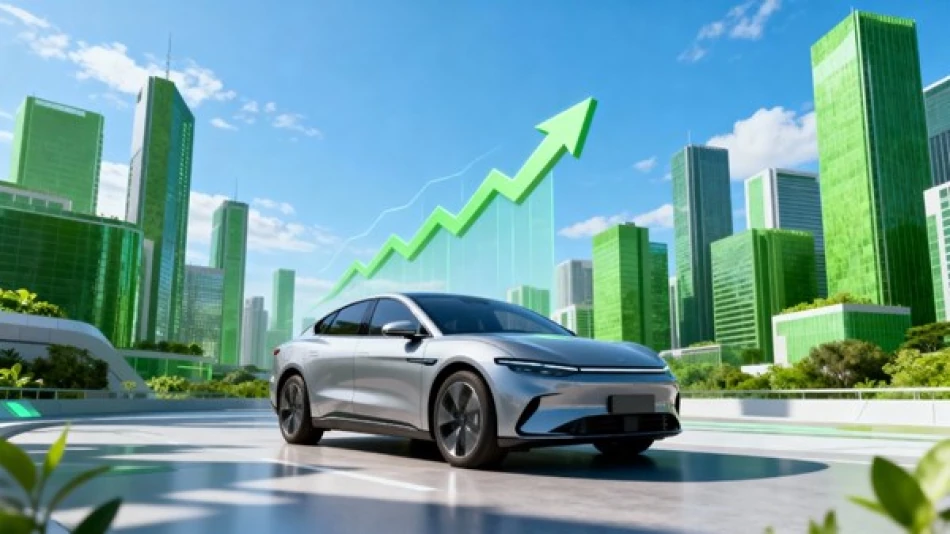
Electric Vehicles Reshape Transportation Landscape
The global electric vehicle market hit a historic milestone in 2024, selling 17.1 million cars worldwide - a 25% jump from 2023. This surge reflects more than just changing consumer preferences; it signals a fundamental shift in how the world moves, with the UAE emerging as a regional leader in sustainable transportation.
The numbers tell a compelling story. China continues to dominate the global market, accounting for 11 million of those sales - more than half the worldwide total. In December alone, Chinese consumers bought 1.3 million electric vehicles, marking a 36.5% annual increase. This dominance stems from strong government support, advanced battery technology, and the ability to produce competitively priced vehicles.
But it's not just about China. Europe saw steady growth with 0.31 million electric cars sold in December 2024, though the pace was more modest at 0.7% annual growth. Britain surprised many by overtaking Germany as Europe's largest electric vehicle market in 2024. However, the European market faces headwinds, particularly from reduced government subsidies in countries like Germany, which has dampened sales. Meanwhile, the US and Canada recorded 0.19 million units sold in December, up 8.8% year-over-year.
The UAE is carving out its own success story in this global transformation. The country's hybrid and electric vehicle market is valued at 11 billion dirhams ($3.01 billion) in 2025, with projections showing it could reach 28.18 billion dirhams ($7.68 billion) by 2029. That represents a compound annual growth rate of 26.37% - faster than many established markets.
What makes the UAE's approach particularly interesting is its focus on luxury and public transportation. Tesla announced it would introduce 200 electric vehicles into Dubai's taxi fleet, aligning with the government's 2030 green mobility goals. Premium brands like Audi, BMW, and Mercedes-Benz are expanding their electric portfolios in the Emirates, catering to the country's wealthy consumer base that increasingly prefers environmentally friendly luxury options.
The transformation is happening across all vehicle categories in the UAE. Passenger cars saw electric adoption jump from 2% in 2022 to 4% in 2023. Light commercial vehicles made an even bigger leap, rising from 0.2% to 1.09% in the same period. Medium and heavy trucks, starting from zero in 2022, reached 0.10% adoption in 2023, while buses climbed from 0.50% to 1.96%.
Passenger cars dominate the UAE's electric market with an 87% share in 2024. This strong presence reflects growing consumer awareness about environmental sustainability, government initiatives encouraging electric vehicle adoption, and expanding charging infrastructure across the country.
Technology Drives the Revolution
The real excitement lies in the technological breakthroughs reshaping the industry. Solid-state batteries represent the holy grail of battery technology, offering higher energy density, longer life, better safety, and ultra-fast charging by replacing liquid electrolyte with solid materials. Companies like Toyota and General Motors are racing to commercialize this promising technology.
Sodium-ion batteries offer another breakthrough. Chinese giant CATL announced its new NAXTRA battery using this technology, which relies on abundant and cheap sodium instead of lithium. This could lead to much more affordable electric cars in the near future.
Charging technology is advancing just as rapidly. XPeng, a Chinese company, is developing ultra-fast charging stations that can fully charge a car in just 10 minutes. Beijing plans to build an extensive network of these stations, making long-distance electric travel as convenient as filling up with gas.
Wireless charging represents the next frontier - imagine charging your car simply by parking it in a designated spot, with no cables needed. Even more ambitious is on-the-go charging, where cars would charge while driving on specially equipped roads. While still in early stages, this technology could eliminate range anxiety completely.
Environmental Impact Beyond Emissions
Electric vehicles deliver significant environmental benefits beyond zero tailpipe emissions. A University of California study found that electric cars reduce carbon emissions by 65% compared to gasoline vehicles over their entire lifecycle. In the US, driving electric cuts carbon dioxide pollution by two-thirds.
The environmental advantage grows as electricity grids become cleaner. As more countries adopt solar, wind, and other renewable energy sources, the carbon footprint of electric vehicles shrinks even further, strengthening their role in meeting Paris Climate Agreement goals.
However, challenges remain around battery manufacturing, which requires mining lithium, cobalt, and other materials. Companies and research centers are developing new technologies to reduce dependence on these materials while improving battery recycling to recover valuable materials and reduce waste.
Economic Transformation
The economic impact extends far beyond the automotive sector. The electric vehicle market is expected to exceed $1 trillion by 2029, attracting massive investments from companies and governments worldwide. In the US alone, electric vehicle incentive programs generated $1.87 in economic benefits for every dollar spent in 2023.
This transformation is creating millions of new jobs across research, development, manufacturing, and charging infrastructure. These opportunities span beyond car manufacturers to include battery production, software development, and energy services.
The shift is also reshaping global supply chains, increasing demand for raw materials like lithium, cobalt, and nickel. This creates opportunities for resource-rich countries but also presents challenges around ensuring sustainable supply and avoiding price volatility. The battery industry, expected to reach $100 billion by 2035, faces challenges from tariffs on raw materials that could affect electric vehicle costs.
Looking Ahead
The momentum shows no signs of slowing. BloombergNEF predicts electric vehicle sales will reach 22 million units in 2025, another 25% increase. Looking further ahead, sales are expected to jump from 15.7 million units in 2024 to 46.3 million by 2035, representing a 10.3% compound annual growth rate.
In the UAE, passenger car electrification is projected to reach 12% by 2030, while light commercial vehicles should hit 6%. The country continues expanding its charging infrastructure, supporting steady growth in electric vehicle adoption through the decade.
Chinese company BYD emerged as the world's largest electric vehicle manufacturer in 2024, selling more than 3.84 million cars with 33.6% annual growth. This success reflects the high competitive ability of Chinese companies in this vital sector.
Electric vehicles represent more than a technological shift - they're driving a complete transformation toward a low-carbon economy, creating new economic opportunities, and improving quality of life. The UAE provides a model for the region, combining strategic vision, smart investments, and international partnerships to become a global center for sustainable mobility. Despite ongoing challenges, rapid innovation and strong global commitment, alongside the UAE's advanced experience in integrating electric vehicles into public transport and expanding infrastructure, make it clear that the future will be electric.
 Layla Al Mansoori
Layla Al Mansoori







